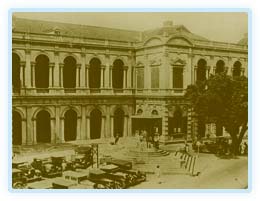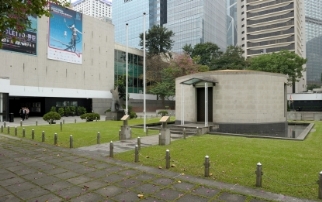 Hong Kong City HallLeisure and Cultural Services Department
Hong Kong City HallLeisure and Cultural Services Department
Introduction


The Hong Kong & Far East Builder, 1962
"A Cultural centre for three million people… ‘The City Hall to be erected here will be the hope and value of the life of Hong Kong people!’ said the Governor at the foundation stone laying ceremony two years ago."
Sing Tao Daily, 1962
| Opened in 1962, the Hong Kong City Hall is the first multi-purpose cultural complex ever built for the community of Hong Kong. Occupying an area of 11 000 square metres on the reclaimed seafront of Edinburgh Place, Central, the City Hall was declared a monument on 20 May 2022 and is protected under the Antiquities and Monuments Ordinance. Its major facilities, including a Concert Hall renowned for its outstanding acoustics, a Theatre well-received by professional theatre groups, as well as an Exhibition Hall capturing view of the Victoria Harbour, are housed in the Low Block. Other minor facilities, such as the Recital Hall, the Exhibition Gallery and the Committee Rooms, which are located in the High Block, are suitable for holding different kinds of events on a small scale. | |
| The old City Hall, built by public contributions in 1869, was a two - storey building with European style colonnades and archways. The building was totally demolished in 1947. During the post-war reconstruction, the idea of rebuilding the City Hall was nurtured due to an imminent need for the revival of culture. The building complex subsequently erected at the present site based on the original design by Professor Gordon Brown, the first Head of Department of Architecture of Hong Kong University, together with his team including Patricia O'Reilly Mayne, was completed by British architects Ronald Phillips and Alan Fitch at the cost of HK$20 million. Its opening ceremony was officiated by Sir Robert Black, the then Governor of Hong Kong, on 2 March 1962. The complex comprises two buildings (High Block and Low Block) and a memorial garden. Its Modernist style with clean lines is a bold deviation from the magnificent Renaissance style of the old City Hall. It has not only greatly enhanced the status of the architectural profession in Hong Kong, but has also taken on the role of popularising arts activities in Hong Kong, promoting eastern and western cultures, as well as expanding the parameters of community activities. |  |
 |
Reputed as one of the most prominent local arts and cultural venues, the Hong Kong City Hall embodies the history of important cultural events and is synonymous with the local cultural development. Milestone events, such as the early Festival of Hong Kong, the first Hong Kong Arts Festival (1973), the first Festival of Asian Arts (1976), the first Hong Kong International Film Festival (1977) and the first International Arts Carnival (1982), all had their inaugurations at the Hong Kong City Hall. Its significant role in promoting arts and cultural exchanges is indeed the pride of Hong Kong people. |
| Over the past six decades, the Hong Kong City Hall has played host to thousands of outstanding local and overseas artists/arts groups, including world-renowned cellist Yo-Yo Ma, the late violinist Isaac Stern, the New York Philharmonic Orchestra, the Vienna Boys’ Choir, the Stuttgart Ballet, the National Theatre of China, Xiang Opera Theatre of Hunan, Fu Ts’ong, choral master Dame Kiri Te Kanawa and Barbara Fei, Chor Fung Ming Cantonese Opera Troupe and many local professional artists/art groups. The rich array of programmes staged here has never failed to enthral the audience. Apart from providing opportunities for the audiences to appreciate performances of various art forms, the Hong Kong City Hall has also contributed greatly to the nurturing of local artistic and cultural talent through the provision of rental subsidy and use of professional venues and auxiliary facilities. | |
| The City Hall High Block also housed the first public library and art museum in Hong Kong. Being the first public library in Hong Kong, the City Hall Public Library was officially opened on 5 March 1962. It is also one of the first six public libraries which apply the Radio Frequency Identification (RFID) technology to provide readers with convenient and efficient smart identification self-charging and self-returning services. Its facilities and services have expanded over the past five decades. Various computer facilities are provided to facilitate the search, reservation and renewal of library materials, as well as the use of electronic resources, databases and digitalised audio-visual materials. Its collection increases from an initial stock of 20 000 items to over 537 000 items, and special reference libraries and thematic collections, such as the Business and Industry Library, the Creativity and Innovation Resource Centre, and the Basic Law Library have been set up. In mid-2014, the Cultural and Historical Resources Corner of Central and Western District was also established to provide information on the culture, history and community development of the District. The inauguration of the Hong Kong City Hall also gave birth to modern museum services in Hong Kong. City Museum and Art Gallery, the predecessor of the Hong Kong Museum of History and the Hong Kong Museum of Art, was located on the top floors of the High Block. With an increasing number of exhibition programmes and museum collections after years of acquisition and collection efforts, City Museum and Art Gallery was officially split into the two said museums and relocated to Tsim Sha Tsui for further enhanced services. |
 |
| Over the past decades, the Hong Kong City Hall has remained an important cultural hub for the community despite the opening of new civic centres. Like any fine musical instrument which needs to be maintained and fine-tuned from time to time for the best performance, the City Hall underwent renovations in 1993 and 2010 respectively to keep abreast of social changes and the development of arts and culture in Hong Kong. While the original architectural style of the City Hall has been retained, modern elements were added to the outlook of the venue. | |
 |
For the people of Hong Kong, the significance of the Hong Kong City Hall goes far beyond the boundaries of arts and culture. This 1960s building remains a landmark of the Central District. While the shrine at the Memorial Garden houses records of wartime sufferings in the territory, the Marriage Registry, which was opened in the same year as the City Hall, bears witness to an important milestone for countless couples who have moved on to a new stage in their life. Over the past 60 years, the Hong Kong City Hall has stood by the people of Hong Kong through thick and thin. It not only offers a stage for artists to display their talent, but also forms part of our collective memories. In the years to come, it will continue to serve as a source of inspiration for artists and contribute to the continual and multi-faceted development of the arts in Hong Kong. |
